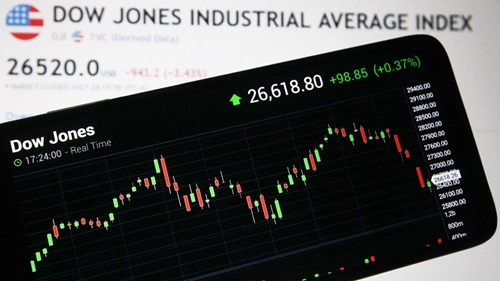The Dow Jones Industrial Average (DJIA) is a well-known stock market index with the largest history and most massive popularity among all stock exchanges. It comprises the 30 leading companies in various sectors of the U.S. economy. These companies are trendsetters in their sectors and are seen as a symbol of the economy’s overall condition. Dow Jones has historically been viewed as a consistently profitable and risk-free path to building wealth over time. By holding the shares, investors can make the most of long-term growth, stability, and diversification. Thus, it turns out to be a good base for its users, especially in the case of the financial sector and retirement programs.
Understanding the Strategies to Invest in the Dow Jones Industrial Average

Knowledge of the diverse perspectives from the assembly of the company for systems to the change of the sector can be the solution for the investors to make the best out of the market turn. These are a few approaches that may be considered:
1. Buy and Hold Strategy: One of the most frequent ways of investing is through a “buy and hold” strategy. The main feature of this scheme is the purchase of stocks of such companies included in the Dow Jones today, which stocks are then held for many years. The clue of this strategy is to observe the stock market growth as a whole. Because the DJIA is made up of 30 well-established firms, their investments allow you to deal with the biggest businesses in the world. This approach enables those who expect the U.S. economy to grow in the long run and, thus, wish to form or even multiply their wealth over the years to secure a good income. Investors who adopt this strategy typically reinvest dividends to maximise their returns.
2. Exchange-Traded Funds (ETFs): Another trendy way is to get involved with Exchange-Traded Funds (ETFs) that are linked to the Dow Jones Industrial Average (DJIA). ETFs are like mutual funds but in a pool of stocks. When buying an ETF, you buy a small piece of the company’s shares. Moreover, one option available is Shares of the underlying DJIA stocks if you are not into picking the individual stocks. Moreover, the SPDR Dow Jones Industrial Average ETF (DIA) is one of the trendiest ETFs that follow the Dow. This approach is good for people who have to diversify but are not qualified enough to pay attention to individual stocks. One can check the Dow Jones outlook to invest in particular stocks.
3. Dollar-Cost Averaging: Dollar-cost averaging is a technique used for an investment where periodic fixed investments into one particular stock or ETF are made for some time, irrespective of their prices. When share prices are low, your fixed investment amount will yield more shares; when they are high, it will yield fewer shares. The net effect is that this leads to lower volatility in the market and makes the average cost of the shares lesser in the time being. Through dollar-cost averaging, investors assume a good way of investing is by knowing Dow Jones stats. This method dispels the emotional factor, which otherwise people would tend to panic during market crashes or, the opposite, be modestly elated during market upturns.
4. Dividend Investing: Many of the companies in the Dow Jones Industrial Average offer their shareholders to receive dividends. If you are an investor focusing on the Dow Jones overview that pays dividends, then the goal is to create a consistent income stream and, at the same time, get your investments to grow. Moreover, dividend investment is a good source of additional income for those who want to earn it and a way of buying stocks without selling. Through the regular and stable paying of dividends from the companies of your choice, you can ensure the availability of a reliable income at any time. The advantage of the Dow Jonesquote is you get to know where to invest and why.
5. Active Management and Stock Picking: Actively managing a portfolio of Dow stocks or picking individual stocks from the DJIA can be done. This approach allows for the selection of stocks the investor feels will perform better. Investors engage in the economic development of the company, its financial strength, and the market trends to decide on buying or selling stocks. However, along with the potential of much higher returns, this trading style is also high risk, as it demands the trader always to be observant and have deep knowledge of the market. It is quite a demanding activity in terms of time and the ability to act based on market changes.
6. Value Investing: It is a method in which investors pursue securities they think are not valued correctly in the market. They look for underpriced companies relative to their intrinsic value based on fundamental factors such as earnings and future growth prospects. Moreover, they set out to purchase these stocks, which are undervalued, with an expectation that the market will sooner or later acknowledge them as precious, which would be reflected in higher share prices. This approach originated with an investor who stands out for identifying undervalued companies that are being traded at a price lower than their real worth.
7. Growth Investing: Growth investing means buying stock in companies that are anticipated to grow above average than a market. This way of thinking emphasises the things that will happen in the future rather than the present. Investors analysing the Dow Jones performance normally can invest in companies with disruptive products, high-earning potential, and a good competitive advantage. These companies do not always distribute dividends; they generally use those profits back to fuel their expansion. The high returns that growth investing affords make it attractive to those willing to take more risk. Moreover, the main risk is that the growth investment’s high expectations might not always be met.
Final Words
In summary, investing with a good strategy enables investors to enjoy long-term growth, stability, and diversification. By concentrating on established firms, Dow Jones is a great investment option. As one determined to be the foundation, it can be a very good part of the diversified allotment. When people endure market ups and downs, they look to the Dow Jones to keep them on the right track and meet the budget plan.
Hina Abbasi is Editor and a passionate sports and entertainment content writer at WinnersMaze.com. Hina’s expertise spans across a wide range of sports, and interest in many TV shows allowing her to deliver insightful analysis and compelling stories that resonate with readers.

